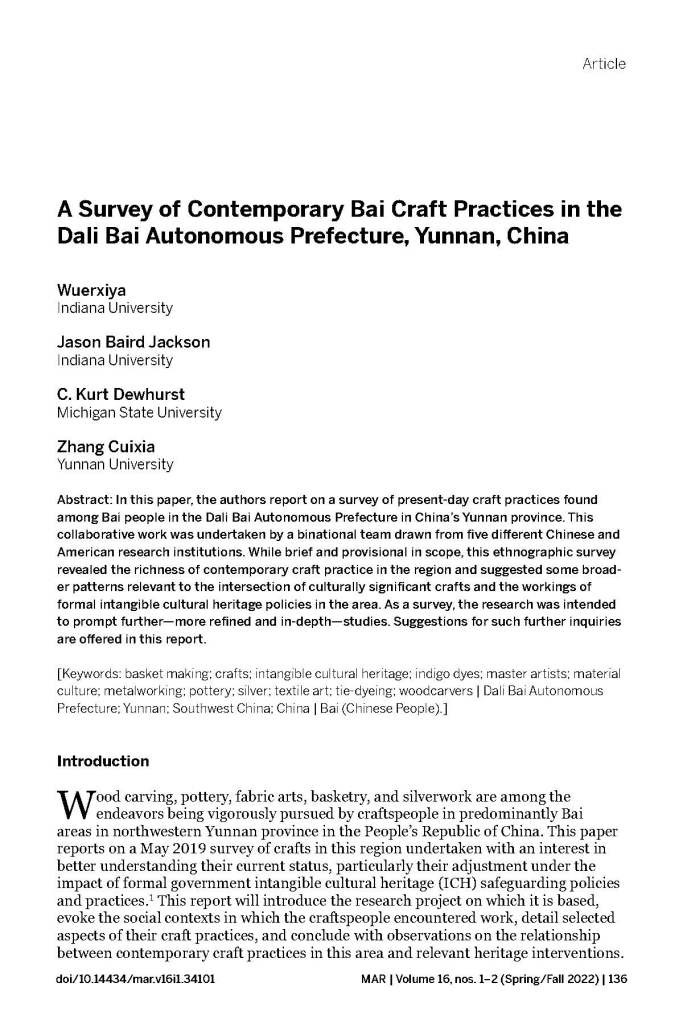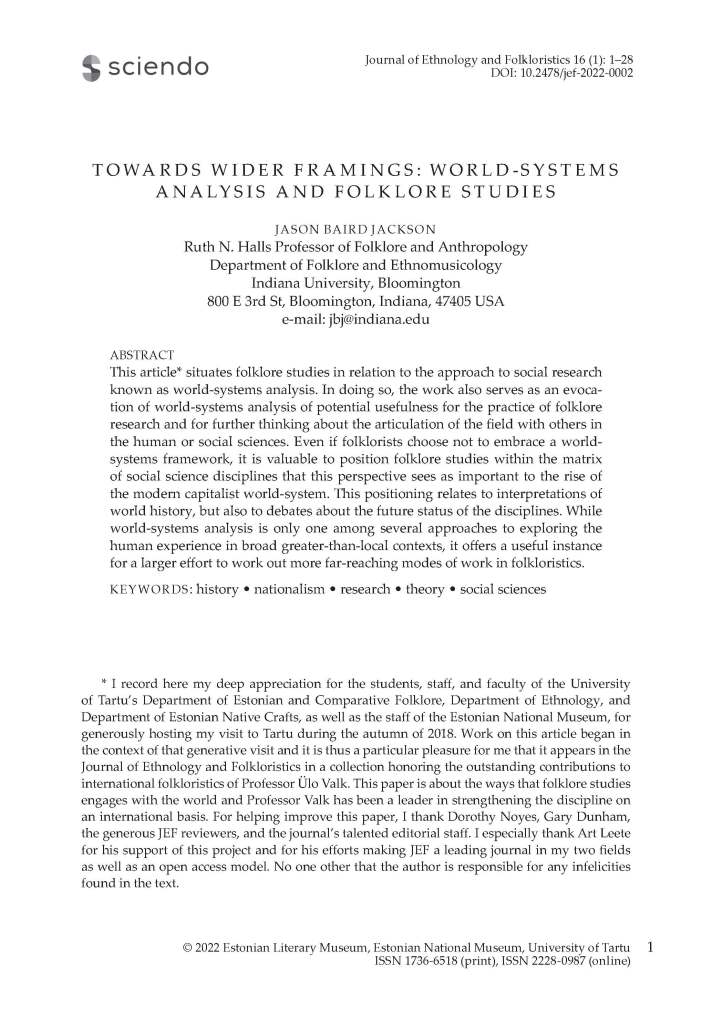Below find the ninth in a series of posts offered in celebration on the occasion of our colleague and friend Daniel C. Swan’s retirement from the University of Oklahoma, where he has served with distinction as a Professor of Anthropology, Curator of Ethnology, and Interim Director of the Sam Noble Oklahoma Museum of Natural History. Here I take a turn reflecting on an an aspect of Dan’s work and his personal impact. This series of guest posts has been organized in partnership with Michael Paul Jordan. –Jason Baird Jackson
Daniel C. Swan, Museum Leader
by Jason Baird Jackson
Earlier posts in this series in celebration of Daniel C. Swan’s retirement from the Sam Noble Museum, and from the University of Oklahoma where it is based, have emphasized mentoring. To impact a more junior colleague positively and to help launch them, or to advance them, in their career is particularly noble work. Since we met one another in the spring of 1994, Dan has been an extraordinary mentor to me and an energetic advocate for me and my work. My career has followed the particular—and wonderful—pathways that it has because of Dan’s deep influence on me and on my lifecourse. This observation could easily be the stepping off point for an essay on Dan’s outsized role as a mentor and supporter to me and to many others. I would love to write that essay.
For others, as for myself, a key part of Dan’s influence as a mentor relates to his providing an observable, emulatable model for collaborations that link communities and cultural organizations for work that addresses the needs or goals of the partner community and that serves society more broadly, while also advancing collaborative scholarly research. While Dan’s involvement in a wide range of such projects in Indian Country are perhaps best known, he has been involved in partnerships and initiatives connecting to, and serving, a still wider range of constituencies and communities. This was true, for instance, in his work as a curator in a an extremely diverse city, while at the Science Museum of Minnesota and I saw it first hand in his work as Senior Curator at the Gilcrease Museum.
In 1999, for instance, we worked together to raise funds for an “Oklahoma African American Folk Arts Survey” aimed at addressing the Gilcrease Museum’s historic neglect of African American cultural life in the state and in the Americas. We brought the Smithsonian exhibition Creativity and Resistance: Maroon Cultures in the Americas to the Gilcrease the following year for the same reason. At a much larger scale, one of his most ambitious and far reaching Gilcrease projects was the major permanent exhibition Las Artes de Mexico. Opened in 1996 and co-curated with Kevin Smith, that project shook things up for Gilcrease and leavened an excellent but little-known collection of Mexican art and documents with contemporary collections and contemporary voices—including Indigenous ones. It was perhaps the first time that a major Gilcrease Museum exhibition was informed by new, project-based ethnographic field research. It was also innovative not just for the museum but for the field in the way that it snuck in a wide range of then emerging best practices and subverted, in a fruitful and innovative way, the then-standard conventions of art-museum-based exhibition presentation and planning. Even the staid Tulsa World captured the sense of what I am getting at here in this June 9, 1996 report by arts reporter James D. Watts, Jr.
I could keep reflecting on Dan’s exhibition projects in this way. Symbols of Faith and Belief: The Art of the Native American Church (a partnered project of the Native American Church of Oklahoma and the Gilcrease Museum), A Gathering of Traditions: A Centennial Celebration of Dr. Charles Marius Barbeau in Oklahoma (a partnership of the Wyandotte Nation, the Seneca-Cayuga Nation, and the Sam Noble Museum) and A Giving Heritage: Wedding Clothes and the Osage Community (a partnered project of the Sam Noble Museum and the Osage Nation Museum) in particular deserve detailed discussion. I hope to write, or to help someone write, that essay. Dan has been involved in a huge number and range of exhibitions and an even larger number of public-facing and community facing programs. These are not well-enough known.
Mentoring. Museum collaboration. Exhibitions. Dan’s accomplishments in these areas warrant extensive discussion. So too with his own research and writing. If you have not read Peyote Religious Art: Symbols of Faith and Belief (University Press of Mississippi, 1999) or Wedding Clothes and the Osage Community (co-authored with Jim Cooley) (Indiana University Press, 2019) yet, I really urge you to do so. On the article side, my favorites include “Early Osage Peyotism” (Plains Anthropologist, 1998), “The North American Lotus (Nelumbo lutea (Wild.) Pers.) – Sacred Food of the Osage (Ethnobotany Research and Applications, 2010), and (with Michael Paul Jordan) “Contingent Collaborations: Patterns of Reciprocity in Museum–Community Partnerships” (Journal of Folklore Research, 2015). It is hard to fathom how Dan found time for so much writing when his administrative, curatorial, teaching, and collaboration duties were so extensive across so many years. His larger oeuvre is remarkable and really warrants separate discussion. I hope to help with that and with helping surface the ways that all of these activities intersected with his teaching work at the universities of Tulsa, Memphis, and Oklahoma.
I am cheating by evoking those other areas here in brief as I do not want them to go unmentioned in the series. But the focus of my thinking today is in museum leadership. Between 2013 and 2019, I served as Director of the Mathers Museum of World Cultures (MMWC). Almost daily during those years, I thought about Dan and about all of the things that I learned from him about leading teams of colleagues within museums. I was really fortunate to have been hired by Dan to work as his understudy and assistant at the Gilcrease Museum during his tenure there as Senior Curator. Dan had begun his own museum career at the Oklahoma Historical Society’s main facility in Oklahoma City and then at the White Hair Memorial, an OHS state historic site and community learning center in the Osage Nation. Before returning to Oklahoma to work at Gilcrease Museum as Senior Cuator, Dan was Curator of Ethnology at the Science Museum of Minnesota. After Gilcrease he served as Director of the University of Memphis’ Chucalissa Museum and finally returned again to Oklahoma to follow me as the Sam Noble Museum’s Curator of Ethnology. Yesterday was his last day in that role and as the museum’s Interim Director. I write this reflection on his first day of retirement.
Museum leadership is often hard, especially in moments such as the current one. In each of his museum leadership roles, Dan made difficult choices with his eyes focused on how to advance the community-service mission of these museums. When I became Director at MMWC, I thought often about how I so regularly watched Dan turn bad news into good news and how he stayed positive and good humored even when this could not be done. There was almost always another day to try again. Every problem could be approached from a new angle. New friends, new funds, new relationships, new ways of organizing the team, new ways of organizing the day, new ways of organizing the collections, could almost always be found and, with them, new progress could eventually be made. The time that I spent at Gilcrease working with Dan and with our colleagues of that period was the most formative in my career. Despite all of the good things that have happened to me since, it remains my own personal golden age. I was shown how to do the work of a curator and given ever more expansive opportunities to do it. I had so much fun to work with Dan and with my other Gilcrease colleagues of that time.
But, I was also watching how the museum’s senior staff, its directors (there were several in a brief period) and especially how Dan, as Senior Curator, did their work. How did museum leaders interact with the board and with funders? Where did the funding come from? How did the leadership group work with the media? With city officials? How were staffing problems dealt with? Controversies? Mistakes? The usual physical plant crises? How did the museum present itself to its audiences and was it diversifying those? With respect to Dan in particular, how did he pull off major projects (the Thomas Moran exhibition, for instance) that went beyond the skills and experiences that the museum’s staff already had? How did he help the teams that he led innovate? I learned so much from watching him and from being involved in the group work that he led the Gilcrease Museum’s curatorial, registration, education, conservation, and programs staff in.
There are many lessons, but one that I thought about most often in my own directorship was the balance that a museum leader has to try to strike between firmness and flexibility, seriousness and fun, expectations (of growth, of productivity, of commitment, of progress) and acceptance (of personality differences, of relative skills, of career investment, of hard realities). In striking this balance, Dan always displayed an equanimity that I never came close to. With the staff, he knew just when the best course of action was to lighten the mood with appropriate humor. Inversely, he knew when frank words were necessary and how to convey them constructively. From my perspective, he knew just when he needed to roll up his own sleeves and join in the physical work of lifting a crate or painting a wall and when he needed to straighten his tie and leave such work to those for whom it was an assigned duty. I wish I had words adequate to describe what I am getting at, but the key thing is that Dan was a model museum leader not just in the sense that he was an excellent one, but in the sense that he literally provided the model by which I and others learned how to also be museum leaders ourselves through his example and influence.
While my time as a museum director is concluded, for now at least, I still use the lessons that I gained form Dan daily. They appear in my courses about museums and curatorship, certainly. They appear in my own mentoring of students and colleagues. But they also permeate my day-to-day work. At present, I am returning to my own research and my own collaborations. In doing so, I am trying to build a new team of collaborators and to revitalize relationships with partners for a post-MMWC period. I am trying to keep existing efforts going while looking ahead to new ones. Doing just this is fundamental to the work that I have watched Dan do for all of the twenty-six years that I have known him.
I am thrilled at the prospect of Dan having, at last, the freedom to take up his projects and pursue his collaborations out of pure interest and commitment without the burden of having to feed a museum’s insatiable demand for new exhibitions, new grants, new reports, new budgets, new donations, and all of the rest.
Dan—thank you for all that you have given and all that you have done. Congratulations!

During the Osage Weddings Project, which led to the exhibition “A Giving Heritage: Wedding Clothes and the Osage Community” and to the book Wedding Clothes and the Osage Community, project participants, including Dan Swan, held consultative events in the Osage community, such as this discussion in May 2015 at the Wah-Zha-Zhi Cultural Center in Pawhuska.















